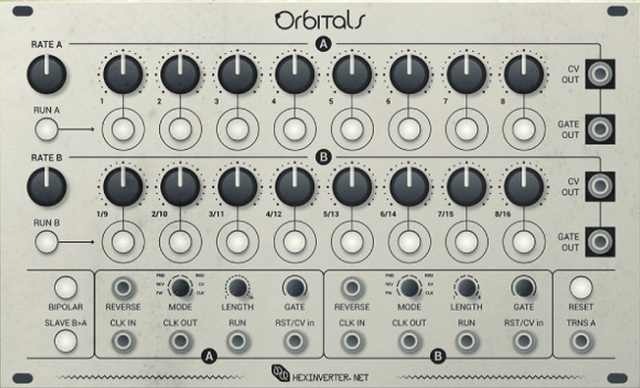HexInverter has announced Orbitals – a DIY 42HP Eurorack analogue step-sequencer kit.
Features:
- 2×8 or 1×16 step analogue sequence modes
- bipolar output mode (on/off)
- two modes of voltage controlled step select (details below)
- forward, reverse, pendulum, random and voltage controlled modes
- each sequence has a reverse input
- sequencer A transpose input for plugging a voltage source (ie: keyboard) into for classic Moog style linear sequencing
- internal or external clocking
- global gate length control (per sequence)
- sequence length control (per sequence)
- global reset button
- reset in per sequence
- run switch per sequence
- run input per sequence
There are two different modes of voltage controlled step addressing: In both modes, the step is selected from a 0-4V control voltage (in 8 step mode, each step is in 0.5V increments. 0.25V increments for 16 steps then, of course):
- Mode 1: Voltage Control (clocked): In this mode, it works somewhat like a sample and hold. That is, the step only updates and generates a new gate/CV based on the input control voltage each time a new clock pulse is received. That is, the voltage control of steps is slaved to the clock source you input. If the voltage stays the same, but it keeps clocking, you’ll get the same CV and gate each time the clock input pulses.
- Mode 2: Voltage Control (quantised): This mode differs from mode 1 in that it is not clock-driven. The clock input for the sequencer basically does nothing in this mode, and instead, each time the input CV steps into a new voltage increment, the sequencer will go to the relative step and generate a new CV and gate for that step. In this way, it basically derives a clock from whatever CV source you input. If you are using a ramp wave to generate a linear sequence with CV, and you increase the frequency of the ramp wave LFO, your sequence speed will automatically follow along with it.
Pricing and availability are still to be announced, but full kits are expected to be less than $280.


Go Hex!!!